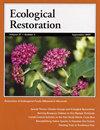Graminification and Reversal of Mesophication in a Restored Oak Woodland
IF 1.1
4区 环境科学与生态学
Q2 ECOLOGY
引用次数: 0
Abstract
ABSTRACT Modern fire exclusion in upland oak- and oak-pine-dominated forests has resulted in reduced flammability of surface fuels as a result of the replacement of flammable fuels of oaks and associated vegetation by less flammable fuels produced by mesophytic trees. Some consequences of such “mesophication” include reductions in herb diversity, C4 grasses, and oak regeneration. We tested two hypotheses of the effects of C4 grasses and tree leaf litter on fuel consumption in the field in restored and unrestored oak woodlands: 1) the presence of C4 grasses increases fuel consumption by a late growing-season prescribed fire (“graminification”), and 2) removing tree leaf fuels reduces fuel consumption by a late growing-season fire to a greater extent in areas lacking substantial, slow-to-dry mesophyte tree leaf litter (mesophication reversal). Consistent with graminification, removing C4 grasses in a restored oak woodland reduced fuel consumption, and fuel consumption was greater following tree leaf litter removal in restored woodland plots containing C4 grasses than in areas that had not been restored and that lacked such grasses. Consistent with mesophication reversal, removing tree leaf fuels reduced fuel consumption to a greater extent in areas where tree leaf litter was dominated by pyrophytic oaks than in an untreated area with a significant amount of mesophyte tree leaf litter. We conclude that mesophication can be reversed at early stages of restoration by thinning mesophytic trees and opening the canopy. Increases in C4 grasses (graminification) at late stages of restoration further increase flammability.恢复后的橡树林地的Graminification和中磨圆反转
摘要:由于橡树和相关植被的可燃性燃料被中生树产生的不太易燃的燃料所取代,以山地橡树和橡树松为主的森林中的现代防火措施导致地表燃料的可燃性降低。这种“中间化”的一些后果包括草本植物多样性、C4草和橡树再生的减少。我们测试了C4草和落叶对恢复和未恢复的橡树林地田间燃料消耗的影响的两个假设:1)C4草的存在通过生长后期规定的火灾(“禾本科化”)增加了燃料消耗,和2)在缺乏大量、缓慢干燥的中生植物落叶的地区,去除树叶燃料在更大程度上减少了生长后期火灾的燃料消耗(中生逆转)。与禾本科化一致,在恢复的橡树林地中清除C4草降低了燃料消耗,并且在含有C4草的恢复林地中清除落叶后,燃料消耗比未恢复和缺乏C4草的地区更大。与中间质逆转一致的是,在落叶层以焦分解橡树为主的地区,与有大量中间质落叶层的未处理地区相比,去除树叶燃料在更大程度上降低了燃料消耗。我们得出的结论是,在恢复的早期阶段,可以通过疏伐中生树和打开树冠来逆转中生作用。C4草(禾本科化)在恢复后期的增加进一步增加了可燃性。
本文章由计算机程序翻译,如有差异,请以英文原文为准。
求助全文
约1分钟内获得全文
求助全文
来源期刊

Ecological Restoration
Environmental Science-Nature and Landscape Conservation
CiteScore
1.70
自引率
12.50%
发文量
24
期刊介绍:
Ecological Restoration is a forum for people advancing the science and practice of restoration ecology. It features the technical and biological aspects of restoring landscapes, as well as collaborations between restorationists and the design professions, land-use policy, the role of education, and more. This quarterly publication includes peer-reviewed science articles, perspectives and notes, book reviews, abstracts of restoration ecology progress published elsewhere, and announcements of scientific and professional meetings.
 求助内容:
求助内容: 应助结果提醒方式:
应助结果提醒方式:


